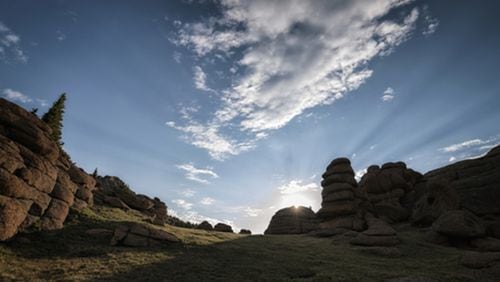COLORADO SPRINGS, Colo. — A mighty, untamed expanse of natural wonder lies between Colorado’s two largest cities, about 50 miles either way of the ever-growing metros, existing as proof that time does not always win.
In the early 20th century, man tried to submerge the land. Under the gaze of imposing granite domes and rock monoliths and spires, deep in the canyon’s lush forest, a company thought to build a dam where the stream disappears underground — the strange phenomenon giving the name to what is now the 119,790-acre Lost Creek Wilderness.
The water refused to be manipulated. What remains of those expensive efforts are withered, log structures where engineers used to live, just east of the rusted, iron contraptions they built.
Near there one recent morning, two backpacks sat abandoned, likely dropped by explorers who had gone into some cave or chamber formed by the massive boulders nearby. Surely, they figured, chances were slim of another passerby entering this remote backcountry, and the chances of one with ill intent, such as stealing, were even slimmer. Here, the views were spectacular, humbling, and one’s mind could only be on that.
In 2002, the Lost Creek Wilderness again seemed fated for oblivion. But no, the state’s most monstrous wildfire stayed clear of its center, ensuring that hikers still could seek its rare solitude. On our way in, we saw the sun rise over Pikes Peak, making the sky blush over hillsides eaten by the Hayman fire. We drove along a ridge, looking out to the glowing swaths of aspen taking the place of blackened trunks.
While the seasons change, the Lost Creek Wilderness hardly does. Take it from Gerry and Jennifer Roach, mountaineering legends who authored “Colorado’s Lost Creek Wilderness: Classic Summit Hikes,” a guide to underappreciated plateaus below 13,000 feet. The book details the pristine beauty of the ranges that frame the wilderness: the Tarryall Mountains, the Kenosha Mountains and the more modest Platte River Mountains and Puma Hills.
“Winter’s cold, snowy months are an especially wonderful season to behold,” the Roaches write. “The Lost Creek Wilderness is a place of beauty and mystery where pale winter light mixes the primary colors of granite, evergreens and windswept tundra as an artist mixes paints on a palette. This special place is gentle to the mind and soul.”
They found that “icy blasts and harsh environments do not often penetrate” here, that avalanche dangers are low, and that the snow and ice melts more quickly — as if Mother Nature is inviting more of us mortals to these 130 miles of trail.
Yet it’s not uncommon to embark into the Lost Creek Wilderness and see no one. And that is another miracle about the paradise in fairly easy reach of Colorado Springs and Denver.
From the latter, Matt Enquist first drove to Lost Creek on a recommendation from a friend he climbed with in Rocky Mountain National Park. He since has spent countless fall weekends in the wilderness, always finding somewhere new to camp.
“I just remember it being so different than so much of what I’d seen in Colorado,” he said of those early ventures. “A totally different geology, and so much less crowded, especially compared to what I was used to in Rocky Mountain.”
With the park coming off a year of record-breaking visitation, Enquist has published a Colorado Mountain Club guide on his new favorite place.
“The Best Lost Creek Wilderness Hikes” proposes 20 trips, from short hiking loops to multiday backpacking journeys. The book showcases the variety that makes the wilderness, yes, miraculous.
Wellington Lake is overlooked by a castle-shaped rock formation and is a draw for the whole family, accessed in less than a mile on foot. Another awe-inspiring formation is the chameleon-looking Lizard Rock, on top of which, after a moderate climb, the valley splays endlessly.
Reaching Harmonica Arch is a task not to be taken lightly, as it mostly follows unkempt social trails. But the reward is rich: a granite slab that bends like a rainbow at a high point where Pikes Peak joins the panorama. Summer wildflowers burst in the meadows near McCurdy Park and Refrigerator Gulch, where the paths are well-marked but challenging. The classic, rugged splendor of Lost Creek is revealed to those who take them.
Why seemingly so few do might be because of the craze surrounding the higher elevations — this era of “peak-bagging” where accomplishments are measured by feet above treeline, by 14,000-foot-high selfies. Intrigues hide below, such as in the log buildings I visited recently.
I read later that a wild bison herd used to roam around here, in this area called Lost Park. According to an 1892 New York Times article, it was the largest herd outside Yellowstone, but then poachers came.
Now a sign tells about the failed damming operation here and asks people not to burn the structures abandoned in 1913. No one has, and maybe that’s a miracle. Rangers also ask for camping etiquette, and as I pass fire rings and charred trees I think about the threat of people and time.
Back at the scenic point where my group started, we realized we missed the trail registry. We fill a form to proudly mark our brief presence in that place.






